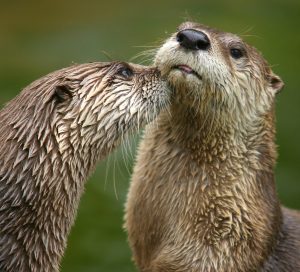
Otters Profile
Otters are mammals with webbed feet that spend some or most of their lives in the water and are generally considered to be solitary. All 13 species of otters are part of the weasel family, Mustelidae, which includes a variety of weasel-like and badger-like species including mink, martens, polecats, wolverines, and honey badgers (also known as the ratel). Otters live in North America, South America, Europe, Asia, and Africa and the distinct species can be loosely divided into groups according to their ecological habitat: aquatic, semi-aquatic, or marine.
The species with the largest distribution around the planet is the European otter, a freshwater species which is native to all of Europe, parts of western North Africa, parts of the Middle East and Central Asia, parts of Eastern Asia, the southernmost tip of India, and the Indonesian island of Sumatra. The marine otter (Lontra felina) is a single species native to much of the Pacific coast of South America from northern Peru southward to Cape Horn and the Falkland Islands in the South Atlantic. This species is not to be confused with the sea otter (Enhydra lutris) which is native to coastal parts of the United States, Canada, Russia, and northern Japan.
All otters are carnivorous. Fish is a component in the diet of all species of otter and some rely heavily on fishing. As a result of their adept fish-catching abilities some human cultures have used tame or domesticated freshwater otters to drive fish into nets. Otters living in or near the ocean will also eat shrimp, eels, abalone, and crabs, while those living in freshwater habitats may eat a variety of shellfish, clams, small amphibians, and even small mammals.
Otters have a number of interesting physical traits and behaviors not seen in many other mammals. Sea otters do not have a layer of blubber to keep them warm in cold waters and instead they have the densest fur of any animal in the world which traps air and helps to insulate them. That, combined with eating up to 25% of their body weight a day, allows them to survive in water that would make many blubber-lacking mammals hypothermic. Otters also have a baculum, or penis-bone, like many species of canine and some species of primates including the common chimpanzee. Like some species of crows and primates, otters have been observed using tools. This trait has been observed in sea otters who use rocks to break open abalone shells and clams for the meat inside.
Expected lifespan in the wild differs from between otter species, but 10-15 years and even up to 20 years in females is common. The North American River otter has been known to live to the age of 25 in captivity.
ENVIRONMENTAL ROLE
Otters living in freshwater play an important role in balancing the ecosystem and river otter distribution may be an indicator of water quality as they prefer to live in or near high-quality sources. Sea otters and other otters living near the sea are known to have a disproportionate impact on the ecosystem through keeping herbivores such as sea urchins from over-populating and destroying kelp forests that are intrinsic to the health of the shallow sea floor.
POACHING, THREATS, & FUR TRADE
Today habitat destruction and pollution, including mining drainage, fertilizer and pesticide runoff, and oil spills, continue to contribute to unnecessary otter deaths of most if not all otter species. In particular, sea otters will lose their fur’s natural insulating properties when exposed to oil as well as receive potentially fatal injuries to their organs. In 2014 sea otter populations in the United States’ Pacific Northwest were identified as hosts of the H1N1 flu virus, indicating that they are at risk of receiving some other types of viruses from humans. The neotropical otter, southern river otter, and giant otter are all native to South America and are threatened by pollution and habitat destruction. The latter is also being threatened by competition from invasive American mink, a relative of otters and a semi-aquatic species once introduced into the region to be farmed for their fur. In Asia habitat loss and poaching are considerable threats facing the Asian small-clawed otter, hairy-nosed otter, and Eurasian (European) otter. Freshwater otters such as the North American river otter and Eurasian (European) otter are similarly threatened by habitat destruction through human development and waste water runoff damaging the otters’ ecosystems.
Young otters, including pups, have a variety of natural predators on land and in the water, including killer whales, predatory birds, and sea lions. Adult otters have a number of predators when on land, including coyote, bobcat, puma, and bears. However legal and illegal fur trapping has taken a large toll on North American river otter populations since at least the 1700s and by the early 1900s wild beavers, otters, minks, and martens had “become scarce” (page 12) in the United States. According to the American Fox and Fur Farmer only the closed season regulations saved the beaver and otter from extinction in Minnesota (page 59), while protection had been bestowed upon some of these species in some states in the early 1800s (page 34).
Between the 1940s and the mid-1970s Latin America became a major producer of skins (pages 79-82). Tens of thousands of otter pelts, and thousands of ocelot and jaguar pelts, were legally exported to the United States and Europe each year. Thousands more were illegally exported (pages 90, 91), however it’s unknown whether the skins were illegally acquired (page 92) or simply illegally exported. Today the international trade in otter fur, as well as a number of other semi-aquatic and aquatic species, is prohibited in many countries. However what legal and illegal trade in furs continues to exist worldwide is not well reported and the country of export is not always the originator of the otter fur (page 11). This leaves the possibility of laundering illegal furs through entrepôts in nations with poor documentation (page 9) or where specific species have no protection status (page 7).
Legal fur trapping still takes place in North America where populations have recovered enough to support it, though some types of fishing still result in purposeful and accidental deaths of sea otters. The United States as well as Canada internationally trade furs of some species in the Mustelidae family and are major fur providers for the Asian market. Canadian mink pelt production accounted for nearly $150 million a year as of 2013 and 2.8 million pelts were produced by farms.
As with many other species, some practitioners of Asian folk medicine believe that parts of the otter have medicinal value, including their bones and blood. While this has not been proven to be accurate, in Cambodia and India otter parts are still sometimes incorporated in certain traditional medicines to treat joint ailments, epilepsy, and is even thought by some to be an aphrodisiac (page 2). In parts of Southeast Asia the desire for otter meat and skins (pages 2, 4, 21) are significant causes for poaching, but otters also lose their lives as a result of accidental bycatch when fishers deploy fishing nets or are killed because they are competing with the fishermen (page 4). Since the late 1980s and early 1990s select markets in Asia have been documented selling local otter species as pets and through the 2000s this trend has grown (page 2) even as more national-level restrictions have been placed on killing and trade in otter species. Although small compared to the scale of the trade in primates, it is estimated that Indonesia alone has at least 800 private owners of otters (page 2). Otters have also been documented being trafficked domestically within Southeast Asian nations for the commercial pet trade (page 22), but also internationally to Malaysia and Japan (page 2). Small shipments of live otters have also been seized in Indonesia, Malaysia, and Vietnam (page 15) where there may be domestic demand for pet otters. In 2014 and 2015 otters could be openly found for sale on common social networks in Malaysia and Vietnam (page 22).
CONSERVATION
Widespread conservation efforts have been necessary several times over the past three hundred years to prevent freshwater otters, and especially sea otters, from going extinct. From 1740 to 1911 it is estimated that roughly 500,000 sea otters were killed as part of the fur trade (Reeves et al., 1992) and indigenous peoples of North America were at times violently pressed into service hunting and skinning otters by Russian fur traders. As a result of early conservation efforts populations stabilized enough to allow the fur trade to resume and regain popularity after the Second World War, however otters still have not returned to all of their original ranges and there are a number of non-governmental organizations and groups dedicated to undertaking trans-location and reintroduction of otters in these areas.
International bans in 1973 and national-level regulation of fur sales were put in place in many countries throughout the 1970s and 1980s to again prevent otter species from going extinct. However demand in Europe and Asia was strong during those decades and while European demand for otter furs eventually lessened significantly, all five species of Asian otters are still illegally hunted to keep up with demand for the Asian market as well as incidental deaths from fisher’s nets. Since the international ban otter populations in many countries and continents have stabilized and increased to sustainable levels despite residual poaching, especially in Asia.
Human development and pollution to our rivers poses a substantial threat to species of otter throughout their ranges. To counter general water pollution some countries and U.S. states have passed legislation for cleaner water, and to mitigate environmental disasters, which has also benefited otters and wildlife in those ecosystems. In California additional efforts have been made to allow sea otters to naturally recolonize former ranges.



